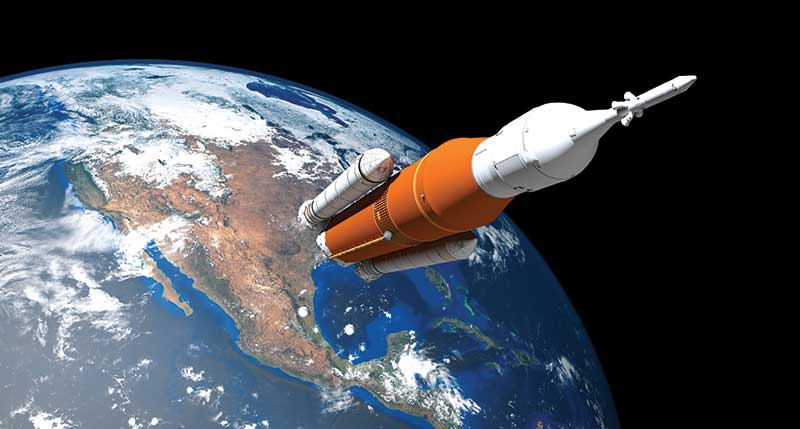Promise the Moon
Article body
Mike Ogles, director of NASA programs in the Samuel Ginn College of Engineering, can’t go a day without hearing it.
“You can’t walk the halls of the Marshall Space Flight Center without seeing someone wearing an Auburn logo or hearing a ‘War Eagle,’” Ogles said. “A lot of Auburn engineers go to work for NASA. Most of them are up in Huntsville at Marshall.”
And on March 26 in Huntsville, just a few months shy of the Giant Leap’s 50th anniversary, all of them heard the challenge. Vice President Mike Pence didn’t mince words. Forget 2028, he said—America would return to the moon within five years, not nine. It wasn’t a prediction. It was an order.
During his speech at the fifth meeting of the National Space Council, Pence urged engineers to double down on “developing the rockets of the future.”
“For more than 60 years, Huntsville, Alabama, has built the finest rocket propulsion systems in the world,” Pence said. “And we want to ensure it remains that way for the next 60 years.”
Enter Auburn University’s additive manufacturing program.
In March, the university landed a $5.2 million contract from NASA to help facilitate the space administration’s Rapid Analysis and Manufacturing Propulsion Technology project, or RAMPT. The three-year investment is the latest in Auburn’s public-private partnership with NASA that established the National Center for Additive Manufacturing Excellence (NCAME) in 2017.
RAMPT is focused on evolving light-weight, large-scale 3-D printing techniques for the development and manufacturing of regeneratively cooled thrust chamber assemblies for the liquid rocket engines necessary not only to return Americans to the moon, but to put the U.S. in the pole position for the race to Mars.
“We believe that when we land on the moon in 2024, our lander will be powered by an additively manufactured engine nozzle designed and developed right here in Alabama,” Ogles told NASA brass and congressional staffers in a June meeting.
Thanks to the decisive investments, including the hiring of prominent experts such as NCAME director Dr. Nima Shamsaei and the $18 million renovation of the Gavin Engineering Research Laboratory which now houses NCAME, Auburn has quickly helped turn Alabama into an international hub for additive manufacturing.
The research funding from strategic partnerships with additional additive manufacturing heavy hitters like NIST, NSF, FAA, the U.S. Navy, and ASTM International hasn't hurt, either. “NCAME currently has over 70 partners,” said Shamsaei, Philpott-WestPoint Stevens Distinguished Associate Professor in mechanical engineering and principal investigator for RAMPT. “We’re working on high impact advanced manufacturing projects to help the industry and the government in faster adoption of this emerging technology.”
Given Pence’s new timeline, that’s good news for folks in Huntsville.
“In order to meet the vice president’s expectations, we need to further develop key technologies such as additive manufacturing, and what NCAME will be doing on the RAMPT project will help us develop the next generation of liquid rocket engines,” said Ogles, who also serves as project manager for RAMPT.
But Paul McConnaughey, deputy director of Marshall Space Flight Center, is quick to point out that Auburn’s research will improve more than just space travel.
“This partnership with Auburn University and industry will help develop improvements for liquid rocket engines, as well as contribute to commercial opportunities,” McConnaughey said. “The technologies developed by this team will be made available widely to the private sector, offering more companies the opportunity to use these advanced manufacturing techniques.”
For now, though, the primary objective isn’t the private sector — it’s the solar system.
“The key to be able to get to the moon and then to Mars is how much payload the rocket can take,” Ogles said. “You have to make the engine as light as possible, and with additive manufacturing techniques we can design rocket engines that have higher performance with a lower weight.
“When we look back in five years, we’ll be able to say that Auburn played a role in taking us back to the moon and putting us on Mars.”
If his recent conversation with NASA Administrator Jim Bridenstine is any indication, others will be saying it, too.
In June, Ogles was representing RAMPT at the NASA Technology Day on the Hill, a fuel nozzle manufactured through direct energy deposition in tow. Bridenstine introduced himself, picked up the nozzle and listened to Ogles’ updates on Auburn’s research. Then he put the nozzle down and looked at Ogles. “War Eagle,” he said.
Auburn University is a nationally ranked land grant institution recognized for its commitment to world-class scholarship, interdisciplinary research with an elite, top-tier Carnegie R1 classification and an undergraduate education experience second to none. Auburn is home to more than 30,000 students, and its faculty and research partners collaborate to develop and deliver meaningful scholarship, science and technology-based advancements that meet pressing regional, national and global needs. Auburn's commitment to active student engagement, professional success and public/private partnership drives a growing reputation for outreach and extension that delivers broad economic, health and societal impact. Auburn's mission to educate, discover and collaborate drives its expanding impact on the world.


